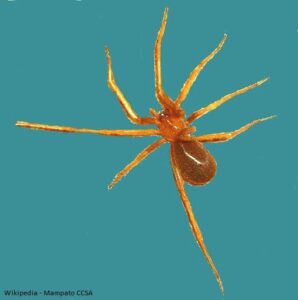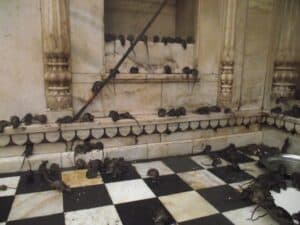In the United States there are eleven native species of brown recluse spiders and two non-native species. Worldwide, there are 100 types of recluse spiders with most of their population in Mexico and Central America. The brown recluse is not aggressive although it is greatly feared; a bite from a recluse can sometimes cause skin lesions. Most bites occur when a spider is trapped against bare skin.
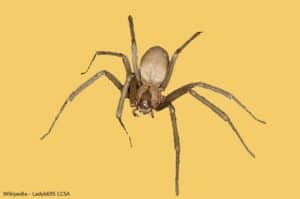
Brown recluse spiders have small fangs and cannot bite through clothing. However, clothing is where this spider likes to hide so it is important to shake out ones clothes and shoes, before putting them on – that is if you live in an area populated by the brown recluse.
Identifying Brown Recluse Spiders
Recluse spiders have just six eyes, most spiders have eight but it would take a magnifying glass to count them. It’s unlikely you would have the chance to get that close because these spiders are not web-builders but active hunters.
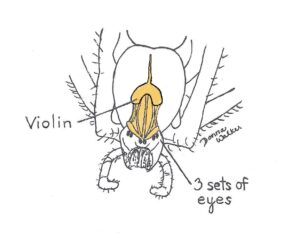
Brown recluse spiders are uniform in color with one very identifiable marking on their head which is shaped like a violin. Depending on species, the violin shape may be hard to see. The L. reclusa in the south has a dark violin shape on top of its head but the southwestern recluse spiders are paler in overall color, including the violin marking. Brown recluses vary in size but on average, they’re about the size of a quarter, including their legs.
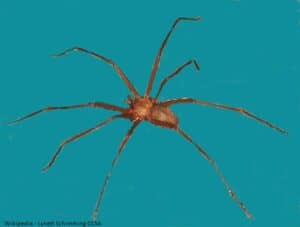
Distribution of Brown Recluse Spiders in North America
The states with the most species of recluse spiders are Missouri, Oklahoma, and Kansas. A family in Lenexa, Kansas, reported finding just over 2000 brown recluses inside their home within a six month period! As one travels westward, recluse spiders are harder to find. In the southwest – Arizona and in the eastern desert regions of California, one can find the L. deserta, a pale-colored brown recluse also called the California violin spider. This recluse has not been found in non-desert, urban areas of the state.
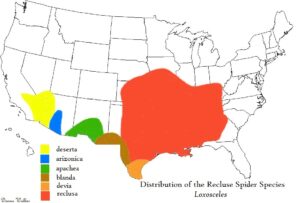
Very rarely is a spider correctly identified as a recluse within urban areas of southern California, except for one invader, the South American recluse called the Chilean Recluse (L. laeta) or South American Violin spider. Sightings of this spider have been reported in Los Angeles County (Mallis, Handbook of Pest Control, Tenth Edition, page 1098).
Evidently there is a restricted population of South American violin spiders inhabiting small areas of Sierra Madre, Alhambra, San Gabriel and Monterey Park. However, there has not been one single verified bite incident involving the South American recluse because they usually live in basements and steam tunnels; it is extremely rare to find this spider in someone’s home. (Vector, R. Department of Entomology, UC Riverside, CA 2013).
South American Violin Spider – Chilian Recluse (L. laeta)
Recluse Behavior and Habitat
(In areas where recluses are common)
Brown recluse spiders are active hunters but if necessary, they can survive without feeding, up to a year in some cases. And, they can live up to 4 years! Females use their web-making abilities to produce egg sacs of which there are 30 to 80 eggs per sac. They also make irregular webbing for their daytime retreat. Cobwebs and webs along fences and in eaves are made by other types of spiders, not the recluse.
Outdoors, recluse spiders hide during the day under rocks, woodpiles, and debris, then hunt at night seeking prey, either dead or alive. Most spiders prefer their insects alive but the recluse spider does not discriminate. Adult females tend to stay near their retreats whereas males and juveniles travel further in search of food.
Indoors, recluses like to squeeze into tight places, especially in cardboard boxes, wood, and even piles of clothing. It’s usually the male that wanders into shoes, clothing or bedding at night. If bitten, it’s because the spider has inadvertently become trapped against the skin.
Management of Brown Recluse Spiders
Many harmless brown spiders found indoors are mistaken for the brown recluse. Identifying spiders can be difficult because most of us squish first – then ask questions later. In order to have an infestation treated properly, it is prudent to have specimens confirmed by a knowledgeable pest control agent.
In regions commonly inhabited by recluse spiders (see above map), most companies will treat infestations with pesticides. These treatment areas may include; along the base of foundations, in cracks on exterior wall, on sill plates in basements, and inside crawl spaces. Clearing clutter and keeping garage corners swept free of debris will enhance the effectiveness of treatments. Exclusion work by sealing gaps in crevices and along windowsills is also important in keeping all spiders from coming indoors.
Medical Significance
The brown recluse is infamous for its ability to sometimes cause skin lesions with its bite. People living in areas commonly infested with recluses, if bitten, don’t even realize it until three to eight hours later when the bite may become red, swollen, and tender. Not all bites result in skin lesions and most heal within three weeks. In other individuals, the victim may develop a necrotic lesion in which the venom continues to destroy the surrounding tissue and medical help is needed. Regardless, persons bitten by a brown recluse should seek medical attention immediately.
Call today at 1-800-986-1006 for help with a spider infestation. You’re also welcome to complete our contact form and a caring Hearts Pest Management representative will contact you shortly.
References
Brown Recluse Spider– Department of Entomology, University of Kentucky College of Agriculture, 2010
Mallis, Handbook of Pest Control, Tenth Edition, Saunders College Publishing, 2011.
Vetter, R. Myth of the Brown Recluse Fact, Fear, and Loathing, Department of Entomology, University of California, Riverside, CA 2013
